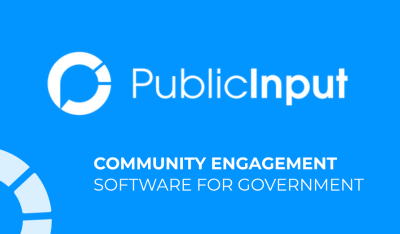Public engagement software is helping consultants become more community-centric — and achieve greater profit, impact, and trust along the way.
After being part of the architecture/engineering consulting community from the mid-2000’s onward, one unsettling pattern has become quite clear.
Despite more ways to connect with residents than ever before, civic engagement and trust in our public institutions is at an all time low.
What happened?
The fallacy of ‘If you build it, they will come’
While the blame for declining civic engagement only partly falls at the feet of the planning and design community, it’s clear we haven’t necessarily helped the situation.
Our misstep? Placing our focus on each wave of ‘shiny’ new technology rather than the underlying community engagement process.
‘Virtual’ Town Halls arrive to great fanfare… and little else.
With the advent of the Internet, virtual town halls were heralded as the panacea for engagement, yet any planner today will acknowledge that most of these forums have been as sparsely attended as the meetings they aimed to replace.
Social Media demands massive time investments with hit-or-miss R.O.I.
Social media’s arrival on the scene prompted the investment of thousands of hours of staff time into new pages, posts, and hashtags. Having witnessed this phenomenon extend itself to the creation of project Facebook pages (and a subsequent pursuit of likes), you may very well see better ROI sending senior engineers door-to-door.
Mobile apps fall short, raise barriers to participation.
And that’s not to mention the mobile app craze. In the late 2000’s, dozens of companies started schilling mobile apps for residents. “They’ve got an app for dating, why not have one for giving feedback on projects?” Following the pattern of other ‘if you build it’ approaches, the time and effort required to get a handful of residents to download and sign in negated nearly all of the gains of increased connectivity.
The pattern we fall for again and again, is “If you build it, they will come.” Yet, every time we adopt the latest shiny engagement format, we find ourselves back where we started – with little more to show for more effort than ever before.
It’s time to re-write the public engagement script.
The point is not technology.
Or likes.
Or follows.
Or app downloads.
Or website traffic.
The point is serving people.
Until we intentionally put people at the center of our process, the gap between our efforts and desired outcomes will continue to grow.
So where do we start?
Design Thinking: Start with clear intentions
Design thinking has a lot to say about people-centric processes. It beckons us to ask the hard questions like “why are we doing public outreach in the first place?”
If you can’t get a clear answer to that initial “why”, or the answer is “because this is what we always do for projects like this”, odds are the process is going to waste your time and the public’s.
In a groundbreaking book on why we meet, The Art of Gathering, author Priya Parker sums up the need for intentionality when bringing people together:
We get lulled into the false belief that knowing the category of the gathering—the board meeting, workshop, birthday party, town hall—will be instructive to designing it. But we often choose the template—and the activities and structure that go along with it—before we’re clear on our purpose.”
I’ve seen dozens of public meetings doomed from the start because they were held for the sake of being held, rather than facilitated with a specific purpose in mind. These rituals tend to de-motivate people and leave room for the loudest voices to hijack the agenda.
If we hope to better serve communities, we must start with a commitment to respecting people’s time (and our own) by being intentional about when and why we communicate with the public.
Selectively leverage technology to achieve engagement goals
Being clear about our intentions has another benefit – it allows us to use technology to achieve our goals rather than blindly adopt it for the sake of being ‘innovative’.
Here are a few examples of stated objectives, and technologies we’ve seen applied successfully:
1. We want to get a representative cross-section of our community.
Select the 2-3 most important demographics or attributes you hope to achieve diversity across. Then consistently collect that information at meetings and online. After initial outreach, check back to see who’s missing. Next, instead of spending hours on general social media promotion, use targeted social media advertising to reach exactly the people you’re missing. It’s fast and affordable – about $0.02 per resident reached on Facebook/Instagram – and if your agency uses Nextdoor, there are now ways to conduct geo-targeted outreach for free.
2. We want people to attend our meeting.
With a clear meeting purpose in mind, setup your event using a web-based event management platform with built-in RSVP’ing, add-to-calendar tools, and email/text reminders. Each of these elements makes it more likely that people who encounter meeting information will take action, remember the meeting, and show up.
3. We want to educate the community about this project.
If residents are asked to wade through paragraphs of written details, we’re going to lose their attention. Instead, start with interactive, highly visual survey formats and leverage questions to teach. Our favorite approach for something like this is to use challenge questions – such as “Identify the duplex in a lineup”, or asking “How many new residents move to [your city] each day?” The result is a gentle nudge to open participants up to new ideas and information.
In each of these examples, technology is applied as a means to achieving the stated objective, rather than for technology’s sake.
When applied this way, technology is serving a holistic community engagement process, rather than adding to it.
Selectively leverage technology to save time (and money)
As an industry, consulting firms worship at the shrine of the billable hour. We structure our budgeting, billing, and even profitability on the back of hourly rates. Yet this rigor and careful calculation rarely trickles down to disciplined time allocation on public engagement tasks.
I can’t count the number of times I found myself, or another skilled hourly employee conducting processes that should have been delegated, contracted out, or altogether replaced by technology. A few examples:
-
-
The $70/hour CAD tech transcribing illegible meeting sign in sheets.
-
The $70/hour CAD tech copying/pasting Facebook comments into a Word document.
-
The $130/hour project manager setting up a Squarespace website for a project.
-
The $130/hour project manager setting up a social media page for a project.
-
The $195/hour Associate sifting through a spreadsheet of comments to code themes.
-
Each of these situations can be prevented by applying public engagement software appropriately or eliminating a less-productive layer of technology altogether. Echoing earlier themes, the key is to leverage technology to serve our process, not add to it.
When we become more cognizant of the public engagement practices that destroy valuable time, and are disciplined about approaches that prevent this, we’re more likely to deliver projects on time and under budget.
Consistently “Close the Loop” to build trust
While more intentional and smarter use of technology can set us up to achieve better outcomes, the foundations of long term success are found in communication.
In a series of recent studies, the World Bank pointed out that across the world, agencies and NGO’s were only successful at building public trust when there was a clear act to ‘close the feedback loop’, essentially letting residents know how their input was used.
At a foundational level, this seems simple enough. But in practice the odds are stacked against this happening for a few reasons. At the moment when closing the loop is most important, consultants are often handing off a final report to the agency. And agency staff, careful of churning up dissent, naturally hesitate to send out communications that may not meet universal support.
We see the solution to this as two-fold:
-
-
Include closing the feedback loop as a key element in the project scope or proposal.
-
Use an integrated email/text communications tool to simplify follow-up with participants.
-
We’ve got some example project approach language available for download here, and have built a public engagement software that makes it easy to follow up with participants at scale. The key takeaway though, is to do it.
When wrapping up the project, at a minimum let people know what key themes emerged, and how those are shaping the process moving forward. Even if that’s simply sharing “this report will be sent to elected leaders”, the act of following up is a key predictor of people feeling heard.
That feeling – that one’s voice matters – is the foundation for trust between agencies and residents, and ultimately long-term engagement success.
Re-committing to our role as public servants
If we are to make our profession more impactful for the thousands of communities we serve, we must look with fresh eyes at our role in the broader public process.
I believe everyone I’ve worked with in the consulting profession would agree that they enjoy seeing their work help people. It’s a subtle motivator across every corner of our work, whether planning roadways, transit, downtowns, or parks.
Our profession serves people, and they’re the reason we exist.
With that in mind, as an industry we are primed to achieve even greater impact for people and communities if we:
-
-
Start every project with critical thinking on why we’re engaging the community
-
Selectively use technology to achieve clear engagement goals
-
Selectively use technology to save time and improve our process
-
Commit to closing the loop with participants
-
If we can consistently do these things, not only will we be more successful and profitable as firms, but we’ll also lay the foundation for stronger, more engaged communities for years to come.
Now that’s a future worth building.



